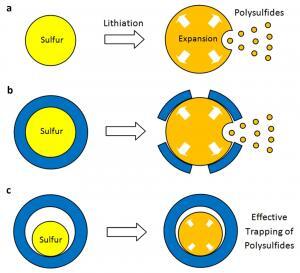Scientists at SLAC and Stanford University have set a world record for energy storage. The innovative design stores five times more energy than commercially available battery storage technology, additional tests show that the system maintained a high level of performance after 1,000 charge/discharge cycles. This is an exciting development as it paves the way for longer-lasting, lighter batteries for portable devices and electric vehicles.
Commercial energy storage solutions today
At the present time batteries are made of lithium ions, they work by moving the lithium ions between two electrodes (cathode and anode). When charging the battery all ions and electrons are pushed towards the anode, when using the battery the ions and electrodes are move back towards the cathode. The long term performance of today’s batteries is typically reduced to around 80 percent after 500 charge/discharge cycles.
Researches have known for some time that sulphur could potentially allow more lithium ions to be stored, and therefore more energy than the current chemical compositions. However, there were several issues that scientists had to overcome as a result of the chemical reaction between the lithium ions and sulphur cathode.
New developments
The breakthrough made by scientists was to develop a cathode made of nano particles, these consist of a ‘yolk’ of sulphur surrounded by a porous ‘shell’ of titanium-oxide. The addition of the titanium-oxide protects the sulphur from dissolving, while the space between the ‘yolk’ and ‘shell’ allows the expansion and contract of the sulphur cathode without cause damage. What made this process more impressive is the scale at which it has been developed, each cathode particle is 800 nanometers in diameter which equates to one-hundredth of the diameter of a human hair.
History of sulphur cathode development
The lead researcher of the project Yi Cui, a Stanford associate professor of materials science, said of the breakthrough:
“This is the highest performing sulfur cathode in the world, as far as we know, even without optimizing the design, this cathode cycle life is already on par with commercial performance. This is a very important achievement for the future of rechargeable batteries.”
Since 2005 Cui’s research group has developed a series of increasingly efficient anodes using silicon as it can store up to 10 times more charge per weight than a carbon equivalent. The future research goal for the group is to combine the sulphur cathode with a silicon anode (both utilising the yolk-shell design) to investigate whether this will produce a high-energy, long-lasting battery.
As the technology is still at the research phase there is no expected time scale for commercial availability, but this development is an important step towards answering some of the criticisms of today’s electric vehicles.
© 2013 Solar Choice Pty Ltd
- NSW Club industry choosing solar power, with help from Solar Choice - 16 October, 2014
- 100% Renewables celebrates solar BBQ success - 26 February, 2013
- Coal fired power station in Queensland to be converted to ‘clean energy park’ - 21 February, 2013

How realistic is battery storage for solar systems at present?
I have registered interest in a home PV solar system including battery storage option, and received numerous quotes and information on PV systems, but none include battery storage options. This leads me to believe that the general industry is immature with respect to battery storage and that pursuing battery storage will lead me to a less competitive market. Is this too being pessimistic?
Hi Brian,
The energy storage industry is getting there, but is indeed still young. The folks who are having system installed right now tend to fall into the ‘early adopter’ category. Nevertheless, the number of products on the market is growing rapidly, and Solar Choice has even introduced a battery storage installation comparison service.